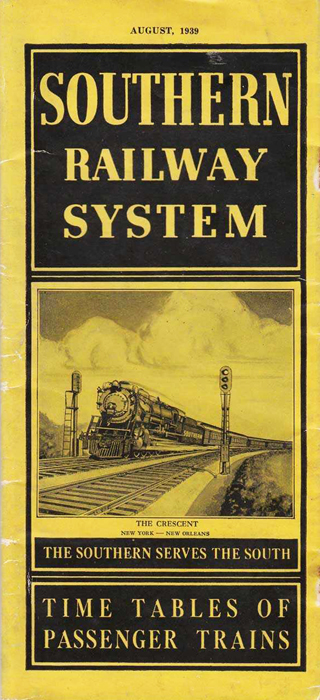Southern Railway System
 The Southern Railway System, formed from the remnants of several failing Virginia lines, was incorporated in Virginia in 1894 and began operating the same year (its earliest predecessor line was actually the South Carolina Canal and Rail Road Company, chartered in 1827, which ran the nation's first regularly scheduled passenger train and later the first night operation). By 1894 the Southern Railway was comprised of at least 125 consolidated railroads, with 75,000 freight cars, over 1,400 locomotives, and more than 21,000 employees. Among those rail lines were several based in North Carolina, including the Carolina & Northwestern Railway, the Atlantic, Tennessee, and Ohio Railroad, and the Atlanta & Charlotte Airline Railway. By 1896 construction had begun on a new rail yard and rail shops in Rowan County; the facility and adjacent town were named Spencer in honor of the Southern's first president, Samuel Spencer.
The Southern Railway System, formed from the remnants of several failing Virginia lines, was incorporated in Virginia in 1894 and began operating the same year (its earliest predecessor line was actually the South Carolina Canal and Rail Road Company, chartered in 1827, which ran the nation's first regularly scheduled passenger train and later the first night operation). By 1894 the Southern Railway was comprised of at least 125 consolidated railroads, with 75,000 freight cars, over 1,400 locomotives, and more than 21,000 employees. Among those rail lines were several based in North Carolina, including the Carolina & Northwestern Railway, the Atlantic, Tennessee, and Ohio Railroad, and the Atlanta & Charlotte Airline Railway. By 1896 construction had begun on a new rail yard and rail shops in Rowan County; the facility and adjacent town were named Spencer in honor of the Southern's first president, Samuel Spencer.
Attempting to stay true to its corporate motto, "Southern Serves the South," the railroad, headquartered in Washington, D.C., extended throughout much of the South, with main facilities in Spencer, Knoxville, Chattanooga, Atlanta, and Birmingham. By the time the line running from Meridian, Miss., to New Orleans was acquired in 1916, the railroad extended 8,000 miles across 13 states-its territorial limits for almost half a century.
Several noted North Carolinians played a role in the development of the Southern Railway. Among them, John Motley Morehead and Alexander B. Andrews served as president of two of the Southern's predecessor lines, the North Carolina Railroad and the Western North Carolina Railroad, respectively.
The Southern was efficient and innovative. By mid-1953, it was the first large railroad to convert its entire operation from steam to diesel engines. Known for excellent passenger service, especially on the Southern Crescent running from Washington, D.C., to New Orleans through Piedmont North Carolina, the Southern also developed novel systems to manage and move freight, such as its oversized grain hopper car known as "Big John." In 1979 the Linwood yard opened in Davidson County, replacing the freight yard a few miles south in Spencer. The former yards and shops at Spencer were donated to the state and reopened as the North Carolina Transportation Museum.
In 1982 the Southern merged with another well-managed railroad, the Roanoke-based Norfolk & Western Railroad. The merger formed the Norfolk Southern Railroad, with headquarters in Norfolk. By the early 2000s most of the old Southern Railway lines and facilities operated under the Norfolk Southern name.
References:
Burke Davis, The Southern Railway: Road of the Innovators (1985).
Albert S. Eggerton Jr., Out of the Past and into the Future: The Bicentennial Story of Southern Railway (1976).
Duane Galloway and Jim Wrinn, Southern Railway's Spencer Shops, 1896-1996 (1996).
Additional References:
Burgess, James L. "Wreck of Number Thirty Six." Raleigh, N.C. 1922. https://digital.ncdcr.gov/Documents/Detail/wreck-of-number-thirty-six/4727429 (accessed August 14, 2012). "Railroads - North Carolina" Vertical Reference File, Government and Heritage Library, North Carolina.
Harrison, Fairfax. "The Future of the Southern Railway in North Carolina: An Address Before the Chamber of Commerce of Raleigh, North Carolina, September 8, 1914." [Raleigh, N.C.]. 1914. "Railroads - North Carolina" Vertical Reference File, Government and Heritage Library, North Carolina.
Southern Railway Company Office of the President. The Floods of July 1916: How the Southern Railway Organization Met an Emergency. Washington, D.C.:Press of Byron S. Adams. 1917. https://digital.ncdcr.gov/Documents/Detail/floods-of-july-1916-how-the-southern-railway-organization-met-an-emergency/501171?item=620478
Asheville Citizen. "Geyser Tribute to Col. Andrews." The News and Observer [Raleigh, N.C.]. January 15, 1922. "Railroads - North Carolina" Vertical Reference File, Government and Heritage Library, North Carolina.
DeButts, Harry A. "Men of Vision 'Who Served the South!'." New York: The Newcomen Society in North America. 1955. "Railroads - North Carolina" Vertical Reference File, Government and Heritage Library, North Carolina.
Giduz, Roland. "Southern's No. 16 Train Makes Farewell Run." The Raleigh Times. March 3, 1964. "Railroads - North Carolina" Vertical Reference File, Government and Heritage Library, North Carolina.
Morgret, C.O. "Southern Has Over Half of Rail Mileage in N.C." The News and Observer [Raleigh, N.C.]. February 9, 1975. "Railroads - North Carolina" Vertical Reference File, Government and Heritage Library, North Carolina.
North Carolina Department of Cultural Resources. "Southern Railway Presents Historic Shops to State." [press release]. July 20, 1978. "Railroads - North Carolina" Vertical Reference File, Government and Heritage Library, North Carolina.
North Carolina Department of Cultural Resources. "Historic Spencer Shops Opens Interim Visitor Center." [press release]. August 14, 1980. "Railroads - North Carolina" Vertical Reference File, Government and Heritage Library, North Carolina.
Carolina and North-Western Railway Company. Carolina and North-Western Ry.: Home Enterprise Developed by Home Talent and Home Money. Yorkville, S.C: L. M. Grist's Sons, Printers. 1915. https://digital.ncdcr.gov/Documents/Detail/carolina-and-north-western-ry.-home-enterprise-developed-by-home-talent-and-home-money/501375?item=622688 (accessed August 16, 2012).
Image Credit:
"Timetable, Accession #: S.1990.25.1." 1939. North Carolina Historic Sites.
1 January 2006 | Bingham, Warren L.